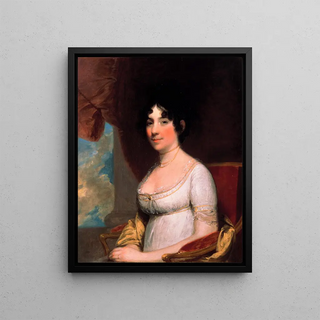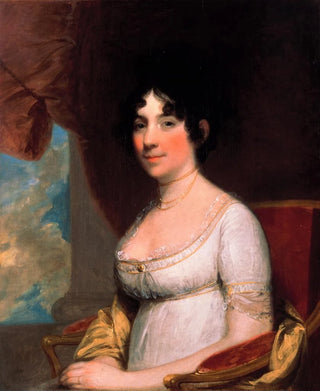Art print | Dolley Payne Madison - Gilbert Stuart


View from behind

Frame (optional)
In the fascinating world of 18th-century American painting, Gilbert Stuart's work stands out for its ability to capture the very essence of his subjects. Among his iconic portraits, "Dolley Payne Madison" proves to be a poignant testament to the era and the personality of this remarkable woman. Wife of James Madison, the fourth President of the United States, Dolley embodies elegance and grace—qualities that Stuart manages to immortalize with unparalleled finesse. This portrait is not merely a simple representation; it evokes a story, a period, and a cultural influence that still resonate today.
Style and uniqueness of the work
Gilbert Stuart's style is often characterized by his realistic approach and his skill in playing with light and shadow. In the portrait of Dolley Payne Madison, every brushstroke seems to have been carefully thought out to pay homage to the radiant personality of his model. Stuart uses a palette of soft and warm colors, highlighting the gentleness of Dolley's face and the richness of her attire. The way he captures details, from her curly hair to the reflections in the fabrics, demonstrates his meticulous attention to authenticity. This portrait also stands out for its composition, where Dolley is placed within a frame that gives her an almost majestic stature, while maintaining an intimacy that invites the viewer to get closer to her world.
The artist and his influence
Gilbert Stuart, born in 1755 in Rhode Island, is often regarded as one of the greatest portraitists of his time. His career, spanning several decades, allowed him to paint many influential political and social figures of his era, including George Washington, whose portrait has become iconic. Stuart's influence is not limited to his artistic talent; he also played a key role in shaping the American visual identity. Through his portraits, he not only captured faces but also stories and aspirations, contributing to forging the image of a nation in the making. His work on Dolley Madison fits into this lineage, bearing witness to a time when women began to play a more visible role in society, while often remaining in the

Matte finish

View from behind

Frame (optional)
In the fascinating world of 18th-century American painting, Gilbert Stuart's work stands out for its ability to capture the very essence of his subjects. Among his iconic portraits, "Dolley Payne Madison" proves to be a poignant testament to the era and the personality of this remarkable woman. Wife of James Madison, the fourth President of the United States, Dolley embodies elegance and grace—qualities that Stuart manages to immortalize with unparalleled finesse. This portrait is not merely a simple representation; it evokes a story, a period, and a cultural influence that still resonate today.
Style and uniqueness of the work
Gilbert Stuart's style is often characterized by his realistic approach and his skill in playing with light and shadow. In the portrait of Dolley Payne Madison, every brushstroke seems to have been carefully thought out to pay homage to the radiant personality of his model. Stuart uses a palette of soft and warm colors, highlighting the gentleness of Dolley's face and the richness of her attire. The way he captures details, from her curly hair to the reflections in the fabrics, demonstrates his meticulous attention to authenticity. This portrait also stands out for its composition, where Dolley is placed within a frame that gives her an almost majestic stature, while maintaining an intimacy that invites the viewer to get closer to her world.
The artist and his influence
Gilbert Stuart, born in 1755 in Rhode Island, is often regarded as one of the greatest portraitists of his time. His career, spanning several decades, allowed him to paint many influential political and social figures of his era, including George Washington, whose portrait has become iconic. Stuart's influence is not limited to his artistic talent; he also played a key role in shaping the American visual identity. Through his portraits, he not only captured faces but also stories and aspirations, contributing to forging the image of a nation in the making. His work on Dolley Madison fits into this lineage, bearing witness to a time when women began to play a more visible role in society, while often remaining in the






